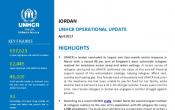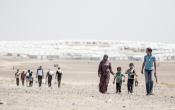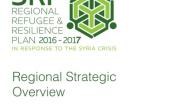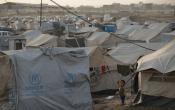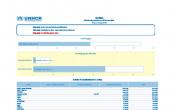Jordan
Operation: Jordan
Location
{"longitude":36,"latitude":31,"zoom_level":7}
Latest update of camps and office locations 21 Nov 2016. By clicking on the icons on the map, additional information is displayed.
Key Figures
| 2016 year-end results | |
| 250,000 | primary health consultations were provided to people of concern and the host communitites |
| 33,000 | households received cash assistance |
| 32,000 | applications for resettelement were submitted |
| 24,000 | refugee households received core relief items |
| 19,000 | refugee newborns were assisted with birth registration |
| 10,000 | shelters were maintained |
| 2017 planning figures | |
| 100% | people of concern will be registered on an individual basis |
| 40,000 | households will be targeted to receive cash grants |
| 5,000 | best interest assessments will be conducted for Syrian children |
Latest Updates and Related Links
People of Concern
5%
Increase in
2016
2016
| 2016 | 720,812 |
| 2015 | 689,053 |
| 2014 | 672,930 |

[["Refugees",685197],["Asylum-seekers",35615]]
Loading ...
Jordan
< Back
2016
{"categories":[2012,2013,2014,2015,2016,2017],"budget":[151.0265589,367.56731878,307.65103446,328.87751632,318.80353781,277.21260564],"expenditure":[85.75910185,234.03438702,206.68124577,208.74308994,218.32880034,null]}
{"categories":[2012,2013,2014,2015,2016,2017],"p1":[151.0265589,367.56731878,307.65103446,328.87751632,318.80353781,277.21260564],"p2":[null,null,null,null,null,null],"p3":[null,null,null,null,null,null],"p4":[null,null,null,null,null,null]}
{"categories":[2012,2013,2014,2015,2016,2017],"p1":[85.75910185,234.03438702,206.68124577,208.74308994,218.32880034,null],"p2":[null,null,null,null,null,null],"p3":[null,null,null,null,null,null],"p4":[null,null,null,null,null,null]}
Loading ...
CHOOSE A YEAR
- 2014
- 2015
- 2016
- 2017
Working environment
Jordan received new arrivals from Syria during the first half of 2016. However, the managed border policy, followed by its near closure, restricted access to asylum, leading to a build-up of asylum seekers at the north-eastern border.A vulnerability assessment found that 93 per cent of the Syrian refugee households residing outside of camps are living under the Jordanian poverty line, with less than USD 96 per person per month.
Violence and conflict in Iraq resulted in a slight increase of new arrivals, with 10,564 Iraqis newly registered in Jordan by year end. Also, in the light of the situation in Iraq, a number of Iraqi nationals who were residing in Jordan before June 2014 continued to approach UNHCR to apply for international protection.
Population trends
- In 2016, Jordan hosted more than 721,000 refugees and asylum-seekers. Compared to 2015, the population has remained relatively stable in terms of numbers even though there was an increase on new arrival admissions by mid-2016.
- 91 per cent of people of concern were Syrians and others were mainly Iraqis.
- In 2016, 53,626 Syrians were newly registered including new arrivals and re-registrations.
- 21 per cent of the Syrians lived in camps, with the vast majority living outside of camps, in urban and per-urban and rural areas.
Achievements and impact
- Capacity in civil registration and for the issuance of status documentation was strengthened, together with the government and partners.
- Cash assistance was provided through biometric-equipped ATM machines to ensure secure transactions and minimize fraud.
- Over 20,000 Syrians who arrived prior to June 2016 were provided with shelter and received core relief items and health and protection assistance in Azraq camp.
- Refugee shelters in Azraq camp obtained electricity coverage.
- Inter-agency coordination remains at the core of UNHCR's refugee response, with a well-developed network of working groups and thematic task forces. Among them, the refugee response established innovative coordination forums regarded as a good practice in the region and at global level and that are being replicated in other locations (i.e. Task Force on Tertiary Education, Protection from Sexual Exploitation and Abuse).
Unmet needs
- Due to lack of funding, community support projects that would facilitate peaceful coexistence between refugee-hosting communities were deprioritized.
- 81 per cent of vulnerable non-Syrian refugees who struggle to meet their daily needs were not reached through UNHCR’s cash assistance programme due to funding shortfalls.
Some 630,000 registered Syrian refugees are living in Jordan, including some 500,000 in urban areas. An estimated 86 per cent of Syrian refugees in Jordan live below the national poverty line. Vulnerabilities are increasing as personal savings are depleted and assistance, such as in the areas of health and food, is reduced as a result of budgetary constraints.
UNHCR will continue to support some 22,500 Iraqis who arrived in Jordan in 2014 and 2015, any new arrivals, as well as refugees from Somalia, Sudan, Yemen and other countries. At least 10 per cent of the non-Syrian refugees in Jordan are considered to be extremely vulnerable.
In 2015, the Government of Jordan launched its 2015 Jordan Response Plan (JRP), which includes separate components to address the needs of refugees and activities to strengthen the resilience of both refugee and host communities. In 2016, UNHCR will continue to support the Government through the JRP process and work to maintain the protection space in Jordan.
UNHCR’s protection and operational strategy in Jordan consists of a two-pronged approach, to address the needs of camp and out-of-camp populations. Advocacy with the Government on international protection standards, and efforts to strengthen community-based protection networks and two-way communication with refugees, are the main areas of focus. Prioritized activities include cash-based interventions, camp coordination and management, and provision of healthcare services. Inadequate funding will further impoverish vulnerable refugees and lead to the danger of greater recourse to negative coping strategies as already witnessed. These include spontaneous returns to the Syrian Arab Republic despite unsafe conditions; child exploitation and labour; begging; taking children out of school; prostitution; and the undertaking of dangerous sea crossings to Europe.
The Government of Jordan is a major provider of services, including education and health services for the refugee population in urban areas, and this role needs much greater support by the international community. It is expected that 2016 should also see more funding for development partners, who can assist in ensuring community-based support to both Jordanians and refugees in urban areas.

